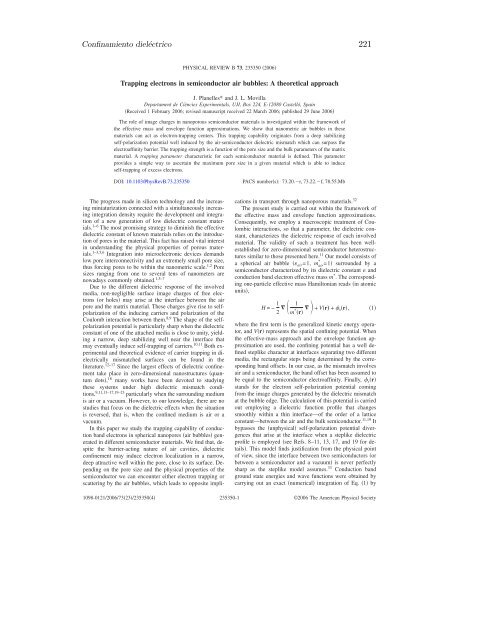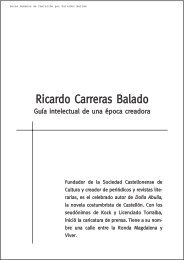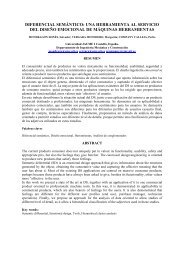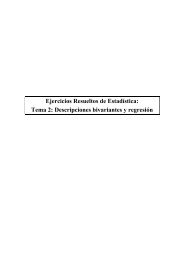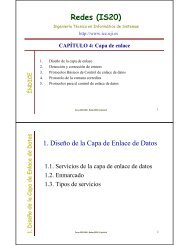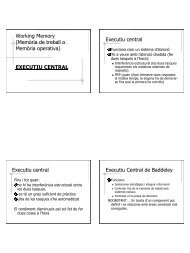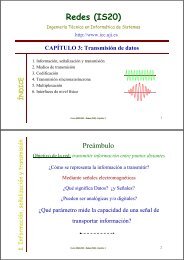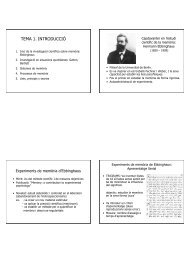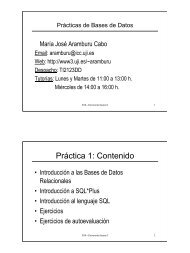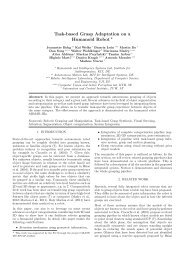CONFINAMIENTO NANOSC´OPICO EN ESTRUCTURAS ... - It works!
CONFINAMIENTO NANOSC´OPICO EN ESTRUCTURAS ... - It works!
CONFINAMIENTO NANOSC´OPICO EN ESTRUCTURAS ... - It works!
Create successful ePaper yourself
Turn your PDF publications into a flip-book with our unique Google optimized e-Paper software.
Confinamiento dieléctrico 221PHYSICAL REVIEW B 73, 235350 2006Trapping electrons in semiconductor air bubbles: A theoretical approachJ. Planelles* and J. L. MovillaDepartament de Ciències Experimentals, UJI, Box 224, E-12080 Castelló, SpainReceived 1 February 2006; revised manuscript received 22 March 2006; published 29 June 2006The role of image charges in nanoporous semiconductor materials is investigated within the framework ofthe effective mass and envelope function approximations. We show that nanometric air bubbles in thesematerials can act as electron-trapping centers. This trapping capability originates from a deep stabilizingself-polarization potential well induced by the air-semiconductor dielectric mismatch which can surpass theelectroaffinity barrier. The trapping strength is a function of the pore size and the bulk parameters of the matrixmaterial. A trapping parameter characteristic for each semiconductor material is defined. This parameterprovides a simple way to ascertain the maximum pore size in a given material which is able to induceself-trapping of excess electrons.DOI: 10.1103/PhysRevB.73.235350PACS numbers: 73.20.r, 73.22.f, 78.55.MbThe progress made in silicon technology and the increasingminiaturization connected with a simultaneously increasingintegration density require the development and integrationof a new generation of low dielectric constant materials.1–6 The most promising strategy to diminish the effectivedielectric constant of known materials relies on the introductionof pores in the material. This fact has raised vital interestin understanding the physical properties of porous materials.1–3,5,6 Integration into microelectronic devices demandslow pore interconnectivity and an extremely small pore size,thus forcing pores to be within the nanometric scale. 1,2 Poresizes ranging from one to several tens of nanometers arenowadays commonly obtained. 1,5–7Due to the different dielectric response of the involvedmedia, non-negligible surface image charges of free electronsor holes may arise at the interface between the airpore and the matrix material. These charges give rise to selfpolarizationof the inducing carriers and polarization of theCoulomb interaction between them. 8,9 The shape of the selfpolarizationpotential is particularly sharp when the dielectricconstant of one of the attached media is close to unity, yieldinga narrow, deep stabilizing well near the interface thatmay eventually induce self-trapping of carriers. 10,11 Both experimentaland theoretical evidence of carrier trapping in dielectricallymismatched surfaces can be found in theliterature. 12–17 Since the largest effects of dielectric confinementtake place in zero-dimensional nanostructures quantumdots, 18 many <strong>works</strong> have been devoted to studyingthese systems under high dielectric mismatch conditions,9,11,13–17,19–23 particularly when the surrounding mediumis air or a vacuum. However, to our knowledge, there are nostudies that focus on the dielectric effects when the situationis reversed, that is, when the confined medium is air or avacuum.In this paper we study the trapping capability of conductionband electrons in spherical nanopores air bubbles generatedin different semiconductor materials. We find that, despitethe barrier-acting nature of air cavities, dielectricconfinement may induce electron localization in a narrow,deep attractive well within the pore, close to its surface. Dependingon the pore size and the physical properties of thesemiconductor we can encounter either electron trapping orscattering by the air bubbles, which leads to opposite implicationsin transport through nanoporous materials. 32The present study is carried out within the framework ofthe effective mass and envelope function approximations.Consequently, we employ a macroscopic treatment of Coulombicinteractions, so that a parameter, the dielectric constant,characterizes the dielectric response of each involvedmaterial. The validity of such a treatment has been wellestablishedfor zero-dimensional semiconductor heterostructuressimilar to those presented here. 11 Our model consists ofa spherical air bubble air =1, m * air =1 surrounded by asemiconductor characterized by its dielectric constant andconduction band electron effective mass m * . The correspondingone-particle effective mass Hamiltonian reads in atomicunits,H =− 1 2 1m * r + Vr… + sr,where the first term is the generalized kinetic energy operator,and Vr represents the spatial confining potential. Whenthe effective-mass approach and the envelope function approximationare used, the confining potential has a well definedsteplike character at interfaces separating two differentmedia, the rectangular steps being determined by the correspondingband offsets. In our case, as the mismatch involvesair and a semiconductor, the band offset has been assumed tobe equal to the semiconductor electroaffinity. Finally, s rstands for the electron self-polarization potential comingfrom the image charges generated by the dielectric mismatchat the bubble edge. The calculation of this potential is carriedout employing a dielectric function profile that changessmoothly within a thin interface—of the order of a latticeconstant—between the air and the bulk semiconductor. 11,19 <strong>It</strong>bypasses the unphysical self-polarization potential divergencesthat arise at the interface when a steplike dielectricprofile is employed see Refs. 8–11, 13, 17, and 19 for details.This model finds justification from the physical pointof view, since the interface between two semiconductors orbetween a semiconductor and a vacuum is never perfectlysharp as the steplike model assumes. 33 Conduction bandground state energies and wave functions were obtained bycarrying out an exact numerical integration of Eq. 1 by11098-0121/2006/7323/2353504235350-1©2006 The American Physical Society


